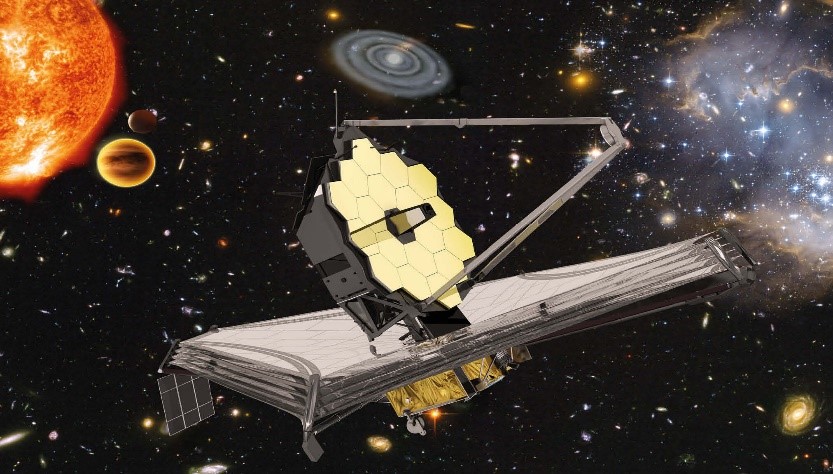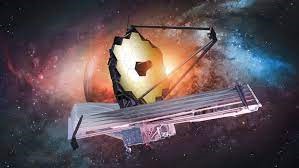Scientific Objectives and Instruments
Webb’s unprecedented scientific power is a function of both the size of its primary mirror and the extreme sensitivity and precision of its four scientific instruments:
- Mid-Infrared Instrument (MIRI)
- Near-Infrared Camera (NIRCam)
- Near-Infrared Spectrograph (NIRSpec)
- Near-Infrared Imager and Slitless Spectrograph/Fine Guidance Sensor (NIRISS/FGS)
All scientific journal articles and many press releases will refer to specific instruments, instrument components, or observing modes used for observations with Webb.

Figure 1. Engineering Marvels of the JWST
Scientific Objectives and Instruments is shown in Figure.1 Each of Webb’s four instruments is like a Swiss army knife of more specialized components, with multiple ways of observing (observing modes). Although some instruments are more suitable than others for observing specific types of objects, all four can be used for investigations of the wide variety of objects that make up the universe, including planets, stars, nebulae, and galaxies.[1]
The James Webb Space Telescope (JWST) isn't just an engineering marvel; it's a scientific powerhouse poised to transform our understanding of the universe. In this part of the blog series, we'll delve into the specific scientific goals and cutting-edge instruments that make the JWST a revolutionary tool for exploring the cosmos.
1. Probing the Early Universe:
One of the primary objectives of the JWST is to peer back in time to the early universe, shortly after the Big Bang. By observing the faint light emitted by the first galaxies, the telescope aims to uncover the processes that led to the formation of structures in the cosmos. It will provide insights into the birth of stars and galaxies and offer a glimpse into the universe's formative stages.
2. Birth and Death of Stars:
The JWST's infrared capabilities allow it to penetrate through dust clouds that obscure visible light. This makes it an ideal tool for studying the formation and evolution of stars. It will reveal the inner workings of stellar nurseries, where stars are born from collapsing gas and dust,and it will track the life cycles of stars from birth to their explosive deaths.
3. Exoplanet Characterization:
The study of exoplanets—planets located outside our solar system—is another cornerstone of the JWST's mission. Using its sensitive instruments, the telescope will analyze the atmospheres of exoplanets, searching for signs of water vapor, carbon dioxide, and other molecules that could indicate habitability or even the presence of life.
4. Solar System Investigations:
While the JWST's primary focus is on the distant universe, it will also contribute to our understanding of our own solar system. It will observe planets, moons, asteroids, and comets, providing valuable insights into their compositions, structures, and interactions. These observations could shed light on the origins of our solar system and the processes that shaped its evolution.
5. Unveiling Cosmic Mysteries:
The JWST's unique observational capabilities will enable researchers to tackle a wide range of astronomical mysteries. It will study the formation of planetary systems, investigate the properties of interstellar dust, explore the environments around black holes, and contribute to our understanding of the nature of dark matter and dark energy.
6. Advanced Scientific Instruments:
The JWST is equipped with a suite of cutting-edge instruments designed to capture and analyze light in the infrared spectrum. These instruments include:
The Near Infrared Camera (NIRCam): Captures high-resolution images and detects the faintest objects in the universe.The Mid-Infrared Instrument (MIRI): Provides spectroscopic and imaging capabilities, enabling the study of distant galaxies, stars, and exoplanets.
The Near Infrared Spectrograph (NIRSpec): Analyzes the spectra of objects, revealing information about their compositions, temperatures, and motions.The Fine Guidance Sensor/Near InfraRed Imager and Slitless Spectrograph (FGS/NIRISS): Helps stabilize the telescope and assists in precision observations, including exoplanet imaging.
7. Unprecedented Precision:
The JWST's instruments are designed to work in synergy, allowing scientists to obtain detailed and precise data about distant celestial objects. The telescope's observations will help address long-standing questions in astrophysics and pave the way for new discoveries.
In summary, the James Webb Space Telescope's scientific objectives and advanced instruments are poised to revolutionize our understanding of the universe. From unraveling the mysteries of the early cosmos to studying the intricacies of star and planet formation, the JWST's capabilities promise to reshape our knowledge of the cosmos and inspire generations of astronomers and researchers. In the next part of this series, we'll explore the journey of the JWST from launch to deployment and its operational phase in space.
References:
- https://webbtelescope.org/news/webb-science-writers-guide/webbs-scientific-instruments
Cite this article:
Gokula Nandhini K (2023), James Webb Space Telescope (JWST), AnaTechmaz, pp.3





